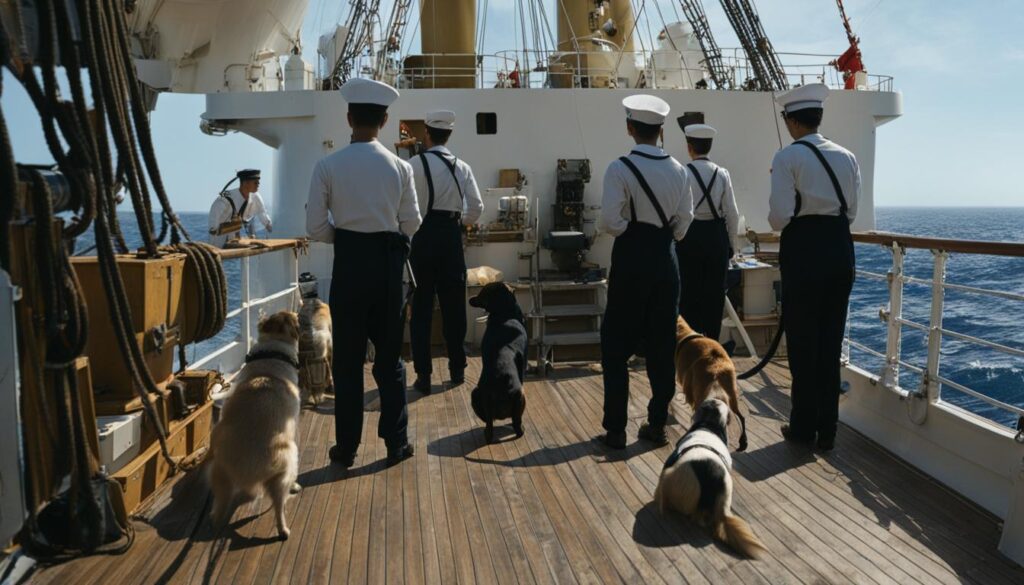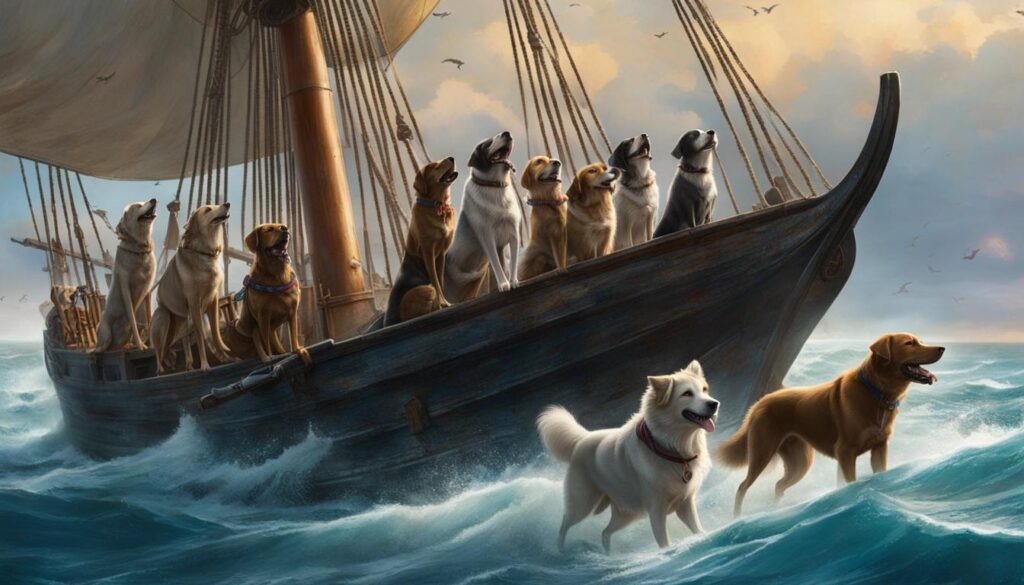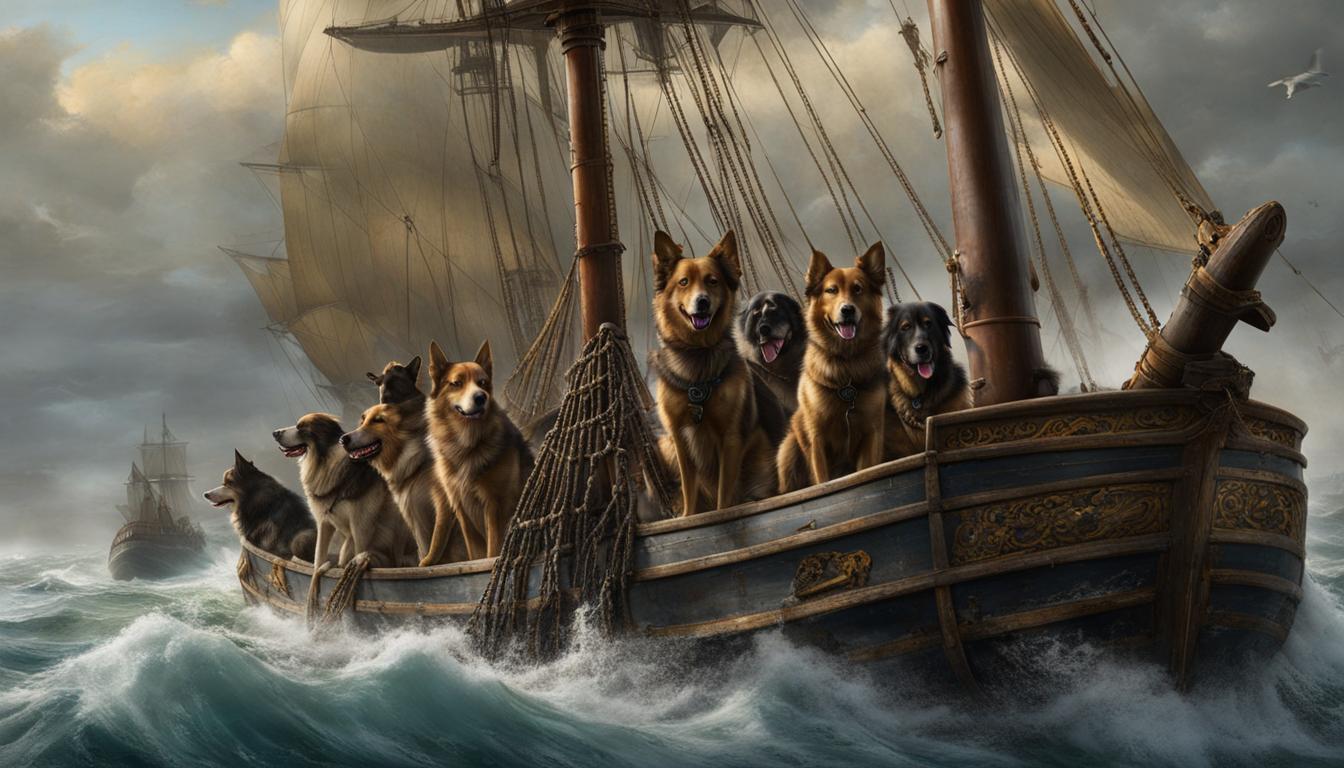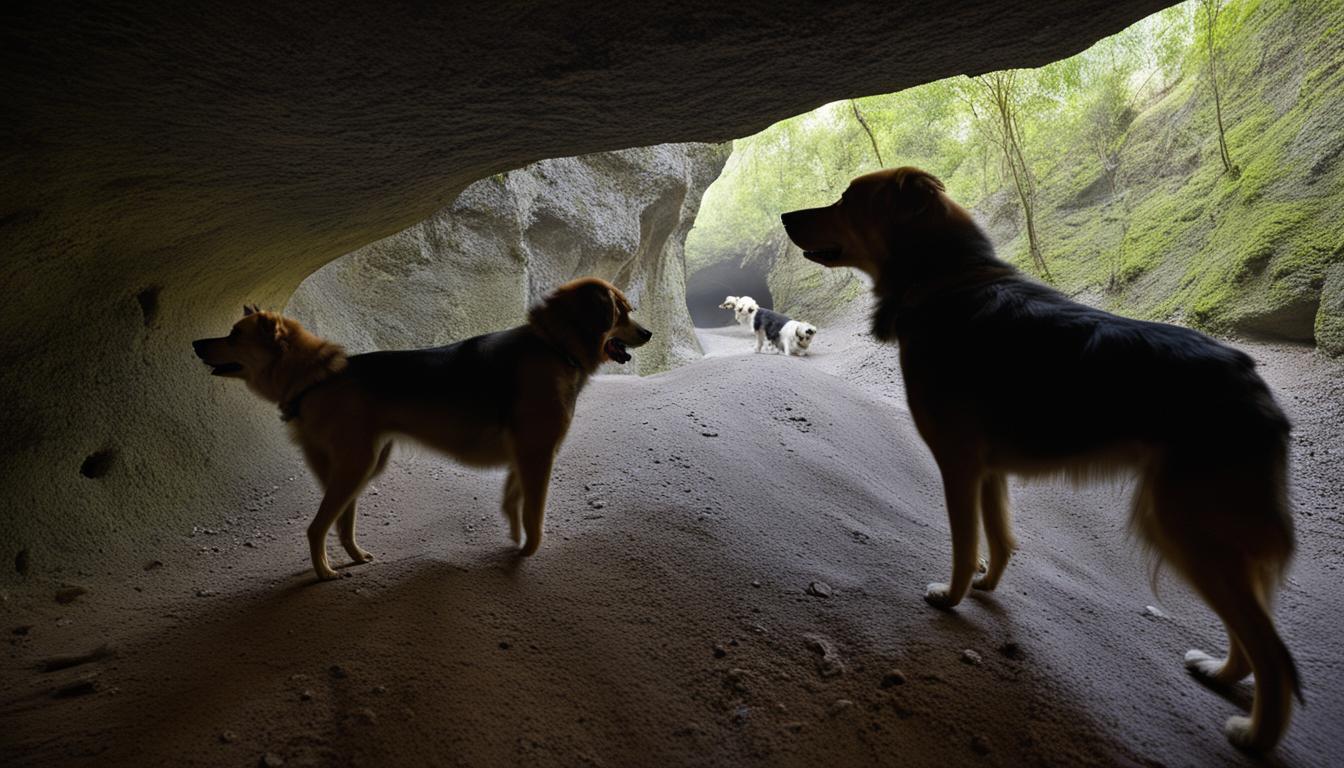Ahoy there, fellow history enthusiasts! Today, we embark on a voyage through time to explore the fascinating world of ancient maritime expeditions and the remarkable role that our four-legged friends, dogs, played aboard those old ships. So, buckle up, grab your imaginary life jacket, and prepare to set sail on a journey like no other.
Key Takeaways:
- Dogs were invaluable companions on ancient ships, contributing to the spread of these animals throughout Europe.
- Dogs served as emotional support to sailors during long and arduous voyages.
- They played a vital role in hunting at ports of call, providing sustenance for the crew.
- Maritime pets, such as Simon the cat and Sinbad the dog, became famous mascots in naval history.
- Maritime museums around the world now showcase exhibitions on the presence of pets at sea.
Dogs as Canine Navigators in Ancient Maritime Cultures
Dogs played a crucial role in ancient maritime cultures as navigators. Sailors relied on dogs’ keen senses and instincts to guide them on their voyages. Dogs were bred and trained to detect and navigate through various conditions such as low visibility, changes in air pressure, and the presence of nearby land. They could sense approaching storms and dangerous obstacles, providing valuable warnings to sailors.
Dogs were also used for rescues, as they could locate people who fell overboard or were lost at sea. Additionally, dogs served as companions to sailors during their long journeys, providing comfort and emotional support. Their presence on ships helped alleviate stress and boredom for sailors who spent months or years at sea. Dogs were considered invaluable members of the crew and were highly respected for their navigational skills.
The Trusty Canine Navigators
“Without our trusty canine navigators, ancient seafaring would have been far more perilous. These four-legged companions provided invaluable guidance, signaling danger and leading sailors to safe harbors. Their acute senses and instinctive abilities were a beacon of hope amidst the vast and unpredictable seas.”
Table: The Role of Dogs as Navigators in Ancient Maritime Cultures
| Dog Navigational Skills | Examples |
|---|---|
| Detecting approaching storms | Canine navigators would exhibit signs of distress and alert sailors to impending rough waters. |
| Navigating through low visibility | Dogs were capable of guiding sailors through foggy conditions or during nighttime expeditions. |
| Alerting presence of nearby land | By sensing changes in scent or subtle shifts in the wind, dogs were crucial in determining proximity to landmasses. |
The trust and reliance placed on these canine navigators cannot be overstated, as their contributions played a vital role in the success and safety of ancient maritime expeditions.

Dogs in the Maritime Warfare of Ancient Civilizations
Ancient maritime civilizations utilized dogs as vital assets in their naval expeditions, leveraging their unique skills and characteristics for warfare purposes.
These faithful companions served as sentries, detecting and alerting sailors to the presence of enemy ships or potential threats. Their acute senses and instinctive nature made them excellent watchmen, providing advanced warnings of impending attacks. In addition, dogs played a role in psychological warfare, instilling fear in the hearts of enemies through their presence and ferocity.
Furthermore, some cultures ingeniously trained dogs to act as weapons on the battlefield. These formidable canines were taught to attack and immobilize enemies, adding an element of surprise and chaos to naval conflicts.
Overall, the historical significance of dogs in naval expeditions cannot be underestimated. From their role as sentries and weapons of war to their invaluable companionship and loyalty, dogs played an integral part in the maritime warfare strategies of ancient civilizations.
| Ancient Maritime Warfare Roles for Dogs | Significance |
|---|---|
| Sentries | Detect and warn of enemy ships and potential threats |
| Psychological Warfare | Instill fear in enemies through their presence and ferocity |
| Weapons | Trained to attack and immobilize enemies, adding chaos to battles |
Table: Ancient Maritime Warfare Roles for Dogs
Ancient Maritime Exploration and the Role of Dogs as Working Animals
Canines played an indispensable role as working animals during ancient maritime exploration. These loyal companions served a multitude of functions on ships and during exploratory expeditions. Dogs were skilled hunters, providing vital assistance in acquiring food on long voyages. Their keen tracking abilities made them invaluable assets, ensuring the crew’s sustenance amidst the vast ocean. Additionally, dogs exhibited remarkable strength and endurance, making them ideal for pulling carts or sleds, which facilitated transportation and assisted in the exploration of new territories.
Emphasizing the significance of their role, dogs were also essential for communication purposes. They acted as messengers, efficiently carrying crucial messages between ships or from shore to ship. This enabled effective coordination and ensured effective communication between different vessels or onshore teams. Beyond their practical utility, dogs served a crucial emotional role as companions to sailors. In the midst of challenging and unpredictable maritime expeditions, these faithful canines provided comfort, companionship, and a sense of normalcy. They were a source of solace and stability in the face of the vast and unpredictable sea.

| Task | Role |
|---|---|
| Hunting | Acquiring food during voyages |
| Tracking | Assisting in exploration and navigating new territories |
| Transportation | Pulling carts or sleds for efficient movement |
| Communication | Carrying messages between ships or from shore to ship |
These integral roles of dogs as working animals in ancient maritime exploration underpin the deep bond between humans and canines throughout history. They were integral members of the crew, providing support, assistance, and companionship in the face of the challenges posed by vast oceans and unknown territories.
Dogs in Ancient Maritime Cultures: Symbolic and Spiritual Significance
Dogs held a special place in the hearts and minds of ancient seafaring civilizations. These loyal companions were not just valued for their practical skills in navigation and protection; they were also seen as symbols of strength, luck, and spirituality.
In ancient maritime cultures, dogs were believed to possess protective qualities. They were often associated with various deities and spirits and were seen as guardians against evil forces. Sailors would perform rituals involving dogs before embarking on their voyages, seeking blessings and protection for their journeys.
“The presence of dogs on our ships brought a sense of comfort and reassurance. They were like an extra layer of protection, warding off any evil spirits that may have tried to harm us.” – Captain Marcus, ancient seafarer
Moreover, dogs were considered to be intermediaries between humans and the divine. It was believed that dogs had the ability to communicate with the spirit world, making them highly respected and sought after. Their presence on ships was seen as a source of luck and strength, providing comfort and companionship to sailors during their long and treacherous voyages.

| Civilization | Symbolic Meaning of Dogs |
|---|---|
| Ancient Egyptian | Associated with the god Anubis, who guided the souls of the deceased |
| Norse | Represented loyalty and protection, often depicted alongside the god Odin |
| Greek | Believed to be the companions of the goddess Artemis, symbolizing loyalty and agility |
The symbolic and spiritual significance of dogs in ancient maritime cultures serves as a testament to the deep bond between humans and canines throughout history. These furry companions were not only integral to the practical aspects of seafaring but also held a sacred place in the hearts and minds of sailors, offering protection and a connection to the divine.
Conclusion
Throughout ancient maritime expeditions, dogs played a multifaceted role that can’t be overlooked. From their position as skilled navigators, guiding sailors through treacherous waters, to their crucial contributions in maritime warfare, dogs proved to be indispensable assets. Serving as sentries and even weapons, these loyal companions boosted the morale of naval crews and instilled fear in enemies.
But it wasn’t just their working abilities that made dogs cherished members of the maritime community. They provided companionship and emotional support to sailors during their long and arduous voyages, helping to alleviate stress and boredom. Whether it was hunting, herding, or even carrying messages between ships, dogs served as indispensable working animals who were strong, reliable, and adaptable.
Beyond their practical contributions, dogs held symbolic and spiritual significance in ancient maritime cultures. Seen as guardians and protectors, they were associated with deities and believed to bring good fortune to seafarers. Performing rituals involving dogs before setting sail sought blessings and protection for their journeys.
The historical role of dogs in seafaring is a testament to the profound bond between humans and canines throughout history. Ancient maritime expeditions with dogs demonstrate their unwavering loyalty, keen senses, and the invaluable support they provided to sailors at sea. Truly, dogs were true heroes of the maritime world.
FAQ
What role did dogs play in ancient maritime expeditions?
Dogs played a significant role in ancient maritime expeditions as companions, navigators, and working animals. They provided emotional support to sailors, guided them through various conditions, and assisted in tasks such as hunting and herding.
How did dogs navigate the seas in ancient maritime cultures?
Dogs in ancient maritime cultures were bred and trained to detect and navigate through low visibility, changes in air pressure, and the presence of nearby land. They used their keen senses and instincts to sense approaching storms and dangerous obstacles, providing valuable warnings to sailors.
What roles did dogs play in maritime warfare in ancient civilizations?
In ancient maritime warfare, dogs served as sentries, warning sailors of approaching enemy ships or potential threats. They also had a role in psychological warfare, instilling fear in the enemy through their presence and ferocity. In some cases, dogs were even used as weapons, trained to attack and immobilize enemies.
How did dogs contribute to ancient maritime exploration as working animals?
Dogs were valuable working animals in ancient maritime exploration. They were used for tasks such as hunting, herding, and transportation. Their strength and endurance were essential for pulling carts or sleds and assisting in the exploration of new territories.
What was the symbolic and spiritual significance of dogs in ancient maritime cultures?
Dogs held symbolic and spiritual significance in ancient maritime cultures. They were believed to have protective qualities and were associated with various deities and spirits. Dogs were seen as guardians, warding off evil spirits, and bringing good fortune to maritime ventures.
What was the historical significance of dogs in seafaring throughout history?
Dogs played an essential role in ancient maritime expeditions, serving as navigators, companions, workers, and protectors. Their presence on ships provided emotional support and companionship to sailors during long voyages. Dogs have been an integral part of the deep bond between humans and canines throughout history.





